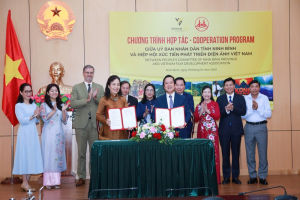The contrast between old and new, rural and urban, makes Vietnam an alluring country for tourism and investment. Bustling street life, exceptional cuisine, and majestic scenery awaits you here. In the city, ancient temples neighbor modern stores and skyscrapers while in rural villages, life flows energetically along the rivers and fields. This unique contrast makes up no small part of Vietnam's attractiveness.
SCENERY
Those who have not been to Vietnam will be surprised by its diverse natural scenery. Tourists are spoilt for choice among countless beautiful sites here.
Northern Vietnam is scattered with picturesque mountains and vast valleys. The northern provinces are famous for their green terraced fields colored by young rice that turns gold in the harvest. In the central region, rivers, lagoons, and white sandy beaches evoke a peaceful way of life. The Mekong River flows through the southern provinces forming a fertile plain that nurtures mangrove forests and islets on its banks.

Travelers who love the sea and sand will have a hard time choosing between the numerous white beaches stretching along Vietnam's coast. The islands of Nha Trang or Phu Quoc are blessed with turquoise waters, soft sand, and brilliant coral reefs. In Vietnam, you're never far from a beach. Even in Ho Chi Minh City, it only takes a short flight to witness turtles laying their eggs on Con Dao's pristine sand.

Among Vietnam's countless impressive destinations, the most prominent are the famed Wonders of the World. Ha Long Bay, just two hours from Hanoi, is surrounded by countless limestone mountains rising from the calm water. Another destination not to be missed is Sapa, a place where majestic mountains and terraced fields lead visitors from one masterpiece of nature to another.

CULTURE
Vietnamese culture has a rich history, dating back thousands of years. Vietnamese people have always prided themselves on a strong connection with customs and traditions.
WORLD HERITAGE SITES
In addition to the Wonders of the World, eight UNESCO World Heritage Sites are spread across Vietnam. Each offers interesting perspectives on local life and the country's majestic natural beauty. The Imperial Citadel and Hue tombs transport you back to the Nguyen Dynasty, while Hoi An Ancient Town gives you a glimpse into its previous life as a bustling meeting point for boats and merchants from around the world. Throughout other provinces and cities, you can encounter ancient relics, poetic scenes, and vivid pieces that paint a picture of Vietnamese heritage.

PAVEMENT CULTURE
The streets are an important part of Vietnamese life. The streets here aren't just for getting around. Streets and sidewalks are also places for trading, eating, drinking coffee, dating, getting your hair cut, or just resting. Big cities are always full of life with the murmur of millions of motorcycles and the chatter of friends and family on the sidewalk. The streets of Vietnam are where the heart of its community truly beats.
NATIONAL IDENTITIES
National culture has always been a highlight of Vietnamese tourism as Vietnam is home to diverse bloodlines. There are 54 ethnic groups divided into hundreds of smaller groups, each with their own ethnocultural identity. Each ethnic group preserves its own culture through rituals, costumes, and language. The best way to get to know these cultures is through real-life experiences such as living with local people, or learning how to weave fabrics with distinctive patterns.

CUISINE
The soul of Vietnamese cuisine lies in its use of fresh ingredients. Discovering amazing food across the country is a never-ending journey.
STREET FOOD
The best "restaurants" in Vietnam are located right on the sidewak. Just follow the smokey scent rising from grills on the streets of Hanoi to find a delicious row of bun cha, or pick up a package of sticky rice from a rattan basket. There's nothing more authentically Vietnamese than a crispy loaf of bread for breakfast or a bowl of pho on winter days. Bon appetit!

REGIONAL CUISINE
Many tourists are unaware of the diversity of food that each region of Vietnam has to offer. Each region has its own cuisine that is the quintessence of the local lifestyle and nature there. The North cherishes exquisite recipes, like the delicious bowl of vermicelli noodles that can take hours to prepare. In the Central region, royal culinary traditions and spices are featured in dishes such as lotus rice or spring rolls. In the South, dishes such as clay pot catfish in caramel sauce and sour soup come from abundant fisheries, the pride of the Mekong Delta.
COFFEE CULTURE
The strong aroma of Vietnamese coffee in the morning is a great alarm clock. Whether in your bedroom or walking to a market for some shopping, the smell of coffee is everywhere. At all times of the day you can catch people hanging out at the hundreds of cafes scattered around big cities. Vietnamese people make traditional coffee with an aluminum filter called a "phin." Quickly popping in and out of a cafe is a foreign concept here, where one passes the time by waiting for the water to slowly seep through the robusta beans. These beans come from the fertile Central Highlands where basalt soil feeds quality robusta coffee trees, giving Vietnamese coffee its distinct bold and complex taste. These coffee beans are one of Vietnam's most beloved export products and you can buy bags of them at numerous stores around the country.

 VFDA organizes a cooperation signing program to promote, build and develop the film industry in Ninh Binh
VFDA organizes a cooperation signing program to promote, build and develop the film industry in Ninh Binh
 Comprehensive Regulation Summary for Filming Production in Vietnam
Comprehensive Regulation Summary for Filming Production in Vietnam
 Legal Documents on Filming in Vietnam and Relevant Matters
Legal Documents on Filming in Vietnam and Relevant Matters
 Legal and Practical Considerations in Vietnam for Foreign Filmmakers
Legal and Practical Considerations in Vietnam for Foreign Filmmakers
Write a comment: